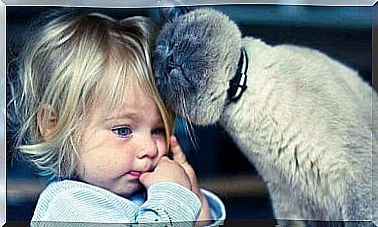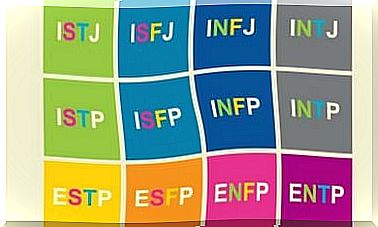What Is Positive Reinforcement And How Do You Use It?

How can we ensure that someone repeats certain patterns of behavior ? How do we increase their incidence? Everything is related to positive reinforcement, a procedure used especially in education and behavior therapy where people seek to strengthen certain desired behaviors or attitudes.
But what else do we know about positive reinforcement? How is it used? What types of reinforcements are there? How is it different from punishment? If you want to know the answers to these and other questions, as well as discover possible reinforcements you can use in your daily life, then read on!
What is positive reinforcement and how do you use it?
Positive reinforcement is a widely used resource in behavioral therapy and education. This type of reinforcement includes all the elements that can increase the probability that a certain response will occur.
We are talking about things that will help us consolidate certain patterns of behavior and help them occur more often. These tend to be, quite logical, appropriate and positive behaviors and attitudes, such as sitting properly at the table.
An important person in this field is BF Skinner, an American psychologist who is known for his behavior theory. He suggested positive reinforcement as a means of reinforcing certain patterns of behavior. According to him, positive reinforcement is all that helps us to repeat the desired behavior.
Skinner distinguished himself for systematically describing the characteristics of this type of learning procedure. In addition to this, he used it in several different fields, and especially in education.
Positive reinforcement is also a technique that forms part of operant conditioning. This is a learning system based on the use of reinforcements and punishments to increase or decrease the likelihood of certain behaviors occurring.
Through this type of procedure , the person creates a connection between his behavior and the consequences of it.

Examples of positive reinforcement
So what is the actual positive reinforcement? Almost anything. It can be praise (verbal reinforcement), objects, gestures, gifts, prizes, words and food, among many other things.
Depending on the nature and characteristics of the positive reinforcement, it may belong to one type or another; There are several types of positive reinforcement. In this article you will discover what these types are.
How to use positive reinforcement
A number of factors will make positive reinforcement more effective. They are related to how you can know what procedure and type of reinforcement to use:
- Immediate. Ideally, positive reinforcement should be applied immediately after the desired behavior (ie the one we want to reinforce) occurs.
- Subsequent. Positive reinforcement should be displayed immediately after the desired behavior, not before or during it.
- Contingent. We should always use positive reinforcement when the behavior we want to reinforce occurs.
- Periodically. This period of the procedure should be extended to consolidate the desired behavior.
- Choice of reinforcement. We need to choose new and diverse reinforcements that can keep the person motivated.
When we use positive reinforcement, we must also take into account the following in order for it to be effective:
- We must precisely specify the behavior we want to reinforce.
- We need to control eventualities (or other reinforcements) that may compete with ours.
- Finally, we must avoid the person getting bored with the reinforcement. In this way, we must ensure that the duration of the reinforcement is not excessive, and we should have an idea of how long it will last.
Reinforcement and punishment
To more clearly understand what positive reinforcement is, we should define the antagonistic relationship between reinforcement and punishment.
Amplification, as we said, is any stimulus that increases the likelihood that a particular response will occur. This can be positive (when the presence of an element increases the behavior) or negative (when the removal of an element also increases the behavior).
An example of positive reinforcement could be praising a child every time they finish breakfast. In contrast, negative reinforcement would be to take away tasks they do not like every time they finish their homework.
Both reinforcements (either praising or removing tasks), if repeated over time right after the behavior we want to encourage, will increase the likelihood of this desired behavior occurring. (In this case, it will be the child who eats all the breakfast or completes his homework).
On the other hand, punishment is the opposite of reinforcement. This will usually reduce the likelihood that the person will make changes in the behavior we want to eliminate.
On the one hand, we have positive punishment. For example, asking a child to stand against a wall, give them a stern conversation or yell at them. On the other hand, negative punishment is to remove something that the child wants. Some examples are taking the TV time from them or forbidding them to go out during the weekend.
Differences between procedures
So the significant difference between the “positive or negative” of both procedures is the addition (positive) or removal / disappearance (negative) of a behavioral element. The main characteristic of the reinforcement procedure is that it seeks to promote the desired behavior. On the other hand, punishment seeks to eliminate unwanted behavior.
Types of positive reinforcement
There are up to a total of sixteen types of positive reinforcement, grouped according to six criteria, according to the Vallejo Behavioral Therapy Manual (2012):
1. What is positive reinforcement ?: According to origin
Positive reinforcement, according to origin (reinforcing value), can be classified as:
- Primary. It has an innate value. For example, food.
- Secondary. These become reinforcements through learning and are more specific.
- Generalized. These are amplifiers of several responses. For example, money or drawing economics.
2. According to the reinforcement process
According to this criterion, positive reinforcement can be of two types:
- Extrinsic. The procedure is open and observable (for example a compliment)
- Intrinsic. The procedure is hidden (for example, a thought)
3. According to the administrator
Depending on who administers the positive gain, it can be of two types:
- Outer. Some manage the reinforcement of the person.
- Self-reinforcement. It is the person who manages the reinforcement internally.
4. What is positive amplification ?: According to the receiver
Depending on the person receiving the reinforcement, we can highlight the following:
- Direct. The person himself receives the reinforcement.
- Deputy. The person observes how another person receives the reinforcement.
5. According to the nature of it
Depending on its nature, positive reinforcement can take the following forms:
- Material or tangible. It has a physical device (such as a bicycle).
- Edible or manipulable. Eaten or manipulated (eg sweets).
- Social. Interpersonal character, including verbal and non-verbal language (eg a hug).
- Active. A pleasant experience for the person (for example, going to the cinema).
- The Premack principle. When low-frequency behaviors, the probability of occurrence increases by being associated with a high-frequency.

6. What is positive gain ?: According to programming
Finally, according to programming, we find the following types of reinforcements:
- Natural. They are very likely to appear in the environment.
- Artificial. They are used under specific conditions.
Upbringing through positive reinforcement
It is clear that the use of positive reinforcement gives very positive results in upbringing. Furthermore, it forms part of broader behavioral programs and treatments, such as ABA therapy ( Applied Behavioral Analysis ), developed by clinical psychologist Ole Ivar Løvaas, and specifically indicated for children with autism.
As we said, positive reinforcement is also part of broader behavioral techniques or programs, such as differential reinforcement of incompatible behavior, differential reinforcement of alternative behaviors, and so on.
In all of them, positive reinforcement is used as a tool that allows a person to strengthen and reinforce the behavior they want to maintain. In other words, those that are adequate or appropriate.
Positive reinforcement is very appropriate, not only to maintain the desired behavior, but also to create (establish) behaviors that do not yet exist.
We find many positive aspects to this resource: Making a child happy with different objects and actions, guiding them in a respectful learning process and motivating them with different reinforcements to help their development. Reinforcement can actually be an educational tool that provides learning.








